Pumping station without accumulator: operation features and water supply devices without hydraulic tank
Thanks to modern equipment, a private homeowner has the opportunity to equip an autonomous water supply system at will. For seasonal living in a country house or in the country, a pumping station without a hydraulic accumulator is quite suitable, although such a solution is used less and less because of its impracticality.
Consider the principle of operation, the pros and cons of a system that works directly from the well or well to the points of drawing. Let us evaluate the feasibility of such a solution, as well as provide options for organizing water supply without a hydraulic accumulator.
The content of the article:
Is it advisable to abandon the accumulator
When designing a system for supplying water to a house, it is necessary to take into account such factors as the number of consumers, the volume of pumped liquid, the resource of a well or well. If water is required on an ongoing basis and in large quantities, then without accumulator just can not do.
A pumping station with a hydraulic tank provides a continuous supply of water to the house, and if a power outage suddenly occurs, then there will be enough liquid supply to complete your business. The volume of the tank is selected based on needs.
The average volume for domestic use is 25-50 liters, but for frequent use it is better to immediately purchase a tank for 100-200 liters or include a drive in the circuit as an addition.
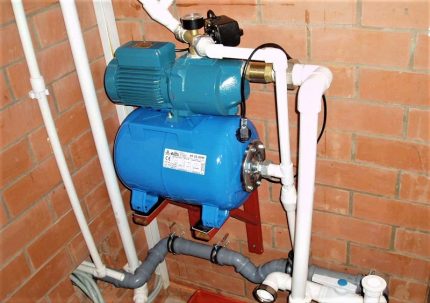
The water supply system can work without a hydraulic accumulator. In fact, it is a pump connected by a pipeline to the points of drawing. The main disadvantage of such a system is the rapid wear of the pumping equipment.
In a system with a hydraulic tank, the pump is switched on only when necessary, here it will turn on every time someone opens a tap with water or wants to water flowers.The engine, due to frequent activation, crashes faster, and the pump has to be repaired or replaced more often than usual.
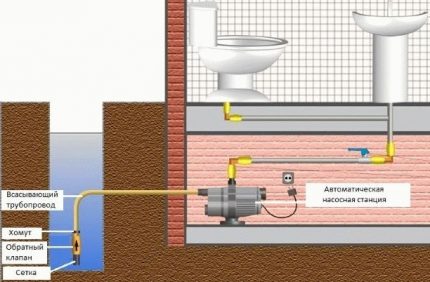
However, manufacturers did not abandon models without a hydraulic tank, because they are in demand. Most often, they are interested in the owners of summer cottages who use water supply system only in the summer period - for recreation, growing vegetables or flowers.
Consider situations in which you can do with one pump, without a hydraulic accumulator:
Thus, if there is no need for a large amount of water, which must be supplied stably, constantly and have a supply, you can do with an ordinary automatic pump. In other cases, a hydraulic accumulator is required.
The principle of operation of the system without a hydraulic tank
The equipment that pumps the water works the same way: it takes the liquid in the source — the well, the well — and pumps it into the house, to the points of tapping. The pump can be either submersible or surface.
The role of connecting highways is performed by pipelines from polypropylene pipes or flexible hoses. In the same way, water is supplied to the bathhouse, garage, summer kitchen, pool.

The difference applies to the use of additional devices, such as a hydraulic accumulator, pressure switch etc. Installing pumping equipment without the means of control and adjustment is extremely dangerous - primarily for the equipment itself.
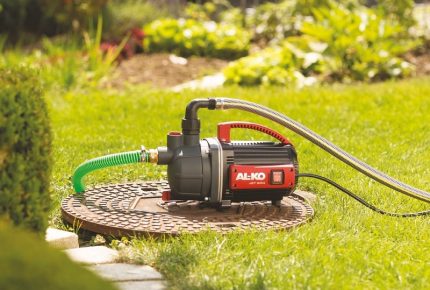
If you need a large amount of water or a more stable supply, another important element is included in the circuit - a storage tank. First, water enters it, and only then - to consumers.
When using domestic pumps, the volume of liquid is usually 2 to 6 m³ / h. This amount is usually enough if the station is connected to a well or a well and serves a country house.
When choosing a unit, it should be borne in mind that the absence of a hydraulic tank accelerates the wear of parts, so the equipment must be durable - with a steel or cast-iron housing coated with anti-corrosion paint.
The pump functions are controlled by a pressure switch, which is responsible for regulating the pressure. For monitoring, it is easiest to install a pressure gauge, which is usually equipped with automation pumping stations.
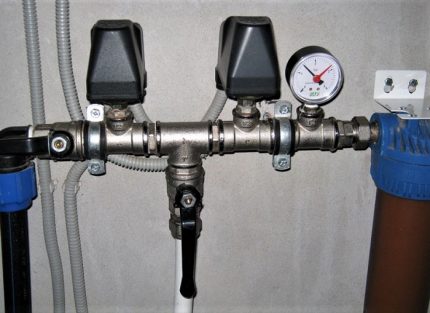
In addition to equipment for pumping water, an electric cable, a connection point to the network and grounding terminals are required.If the turnkey solution does not satisfy the needs, the station parts can be purchased separately, and then assembled already at the installation site. The main condition is the correspondence of the elements of the system according to the characteristics.
Water supply without accumulator
If you exclude the accumulator from the water supply, then two options are possible:
- the use of a pump to supply water to the points of tapping directly;
- connecting the storage tank.
Both options are actively used, but the first is optimal for irrigation systems with a small amount of liquid, and the second is most appropriate when you need to provide water for a shower, kitchen faucet - that is, consumers inside the house.
Option # 1 - connecting the pump directly
There are many interesting solutions, but the most practical and economical are automated irrigation systems. They work only during periods when there is no rain, and are installed wherever regular watering is needed - in the garden, near flower beds, on lawns.
One of the options is an expanded irrigation system for a personal plot. It is fully automated. To set the on / off time, connect the controller. Solenoid valves can be installed on each line so that they can be operated individually.
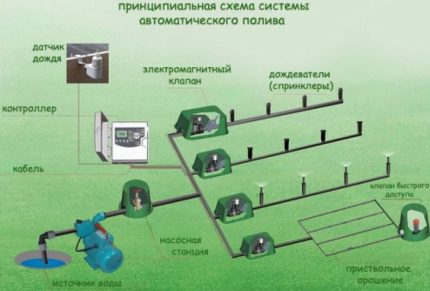
The rain sensor makes the irrigation system more efficient: the pump does not function during rainfall.
The order of installation of the irrigation system:
- we place pipes on the surface of the earth according to a pre-compiled scheme, we connect fittings;
- install sprinklers, drip system, watering hoses;
- equip the pump group - surface unit and pressure switch;
- we connect the water supply, we test the system for leaks;
- if all is well, we dig out trenches 30 cm deep, arrange a drainage pillow from gravel and sand, lay the pipeline and fill it up;
- we re-test to check for leaks, check the performance of all lines;
- connect the controller and rain sensor;
- check the operation of all elements of the system.
If the throughput is small, we set up the alternate operation of the lines. This is a complex circuit that requires knowledge of equipment setup. The simplest is ordinary pump type "Kid" with watering hoses connected to it.
Option # 2 - scheme with a storage tank
With the advent of technological stations with a hydraulic accumulator, the circuit has become less popular, but still in use. It is simple and different in that there is a storage tank between the pump and the taps.
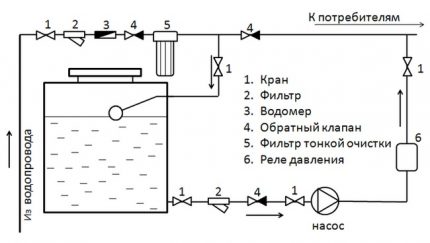
One of the operating conditions of the system is water treatment organization. The first filter is installed on the suction pipe at the surface pumps, on the equipment itself - at the submersible ones. The second is at the entrance to the house. It is better if it is a set of two filters, coarse and fine cleaning.
After the filtration system, a storage tank is installed, and already from it goes a pipe (or pipes) to the points of drawing.
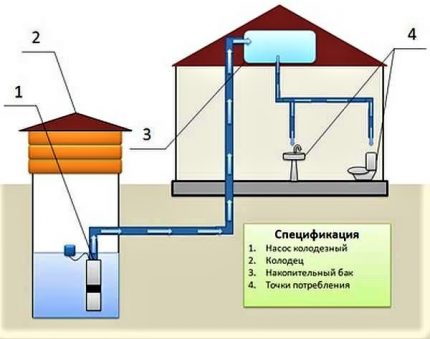
Storage tank - any tank that is suitable in volume. Previously, galvanized metal tanks were used, now plastic containers of various configurations are used. They are equipped with one inlet pipe for supplying water from the well, and two outgoing pipes for distribution to consumers and drain pipes.
On top of the tank is covered with a hinged lid that protects the liquid from debris and dust.By removing the lid, you can analyze the condition of the tank and the water that is stored in it. In case of severe contamination, the liquid is discharged through the drain pipe, and the tank is washed.
The main control element is the float mechanism. As soon as the water level reaches the maximum mark, the inlet pipe is blocked, and the flow into the tank is stopped. At a low level, on the contrary, the inlet opens and water begins to flow into the tank.
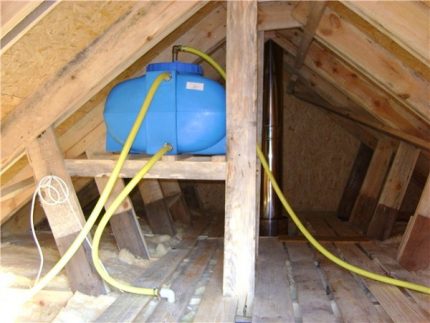
Plus the use of a storage tank: there is always a supply of water that is supplied under a slight pressure, even if all the pumps are turned off. Minus - difficulties in installation. Volumetric tanks require space and a base that can support their weight.
In the case of installation of systems for year-round operation, the attic or at least the tank itself, placed in an unheated attic space, must be insulated.
In order to avoid overflow and flooding of floors located below, drives are necessarily equipped with overflow pipes. If the permissible volume is exceeded, water through the overflow hole arranged in the upper third of the tank will drain through the connected pipe to the sewer.
Positive and negative reviews
How good a system without a hydraulic accumulator is in practice is best judged by user reviews - owners who have been using it in their homes for a year or more.
One of the advantages is the compact size and ergonomics of the pumping station. There is no accumulator, which takes up a lot of space, as a result of which it is much easier to find a small corner for installing the pump.
It is possible to use different types of pumps with equal success, including submersible units- then only piping and control devices will be on the surface.
The cost of the unit without a hydraulic tank is lower, and installation is easier.
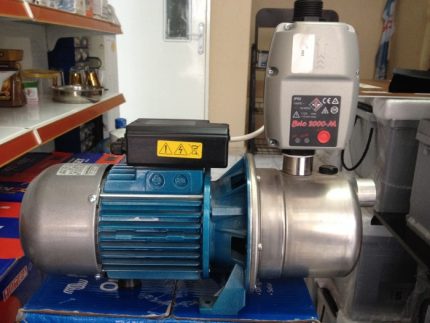
There are also disadvantages, the main one is insufficient power. A system without a hydraulic accumulator has minimal performance, and pumping equipment is constantly at risk of failure.
It is not protected from water hammer, and from frequent on / off, it simply wears out earlier than stated by the manufacturer.
Today, when many models with a hydraulic accumulator with a cost of more than 8,000 rubles are presented on the market, a system with a storage tank is recognized as obsolete and irrational.
Conclusions and useful video on the topic
Overview of the vortex pump with pressure switch:
Automation for pumping stations without hydraulic accumulators:
Connecting the pumping station to the storage tank:
The use of a water supply system without a hydraulic tank at a summer cottage is possible, however it will be limited in power and partially unprotected, even when equipped with automation. It is much more convenient to use a modern pumping station with a hydraulic accumulator, especially to provide the house with the necessary amount of water.
Have experience operating a pumping station without a hydraulic accumulator? Or want to ask questions on the topic? Please comment on the publication and participate in the discussions. The feedback block is located below.

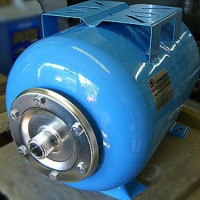 Hydraulic accumulator: device and principle of operation of a hydraulic tank in a water supply system
Hydraulic accumulator: device and principle of operation of a hydraulic tank in a water supply system 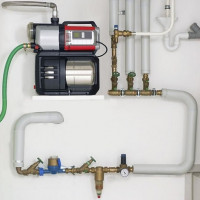 Pumping station for a private house: how to choose and what to look at before buying
Pumping station for a private house: how to choose and what to look at before buying  Connecting a hydraulic accumulator to the water supply system: options and typical schemes
Connecting a hydraulic accumulator to the water supply system: options and typical schemes 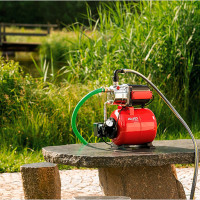 Pumping station for a summer residence: rating of affordable and efficient equipment
Pumping station for a summer residence: rating of affordable and efficient equipment 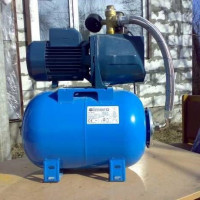 Well pumping station: rules for selecting, installing and connecting equipment
Well pumping station: rules for selecting, installing and connecting equipment 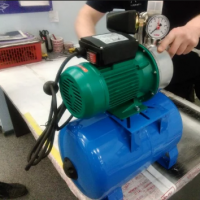 DIY pump station: wiring diagrams and installation rules
DIY pump station: wiring diagrams and installation rules  How much does it cost to connect gas to a private house: the price of organizing gas supply
How much does it cost to connect gas to a private house: the price of organizing gas supply  The best washing machines with dryer: model rating and customer tips
The best washing machines with dryer: model rating and customer tips  What is the color temperature of light and the nuances of choosing the temperature of the lamps to suit your needs
What is the color temperature of light and the nuances of choosing the temperature of the lamps to suit your needs  Replacement of a geyser in an apartment: replacement paperwork + basic norms and requirements
Replacement of a geyser in an apartment: replacement paperwork + basic norms and requirements
In our house, we installed a pumping station without a hydraulic tank: it performs all the functions perfectly, water is supplied without problems, and everything is automatic, comfortable. The average volume of 25 liters. The storage tank does not occupy a large volume, the station is connected to a common well. The tank was located in the basement so that it would not interfere in the house. I can say it is painted and shown perfectly where and how best to install.
Every year from April to November I live in the country. An autonomous water supply system was made in the house - a pumping station without a hydraulic accumulator with wiring from plastic pipes. For watering the garden, we have industrial water from a natural pond, and for household and sanitary needs (wash dishes, brush our teeth) I do not need a lot of water in the house. The second branch of the wiring leads to the bathhouse. The power of the pumping station is enough for us.